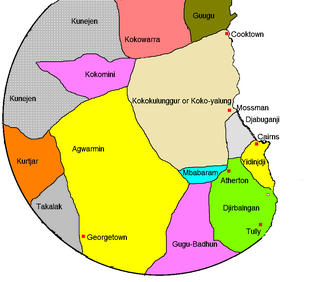Mbabaram language
This article includes a list of general references, but it lacks sufficient corresponding inline citations. (December 2011) |
| Mbabaram | |
|---|---|
| Barbaram | |
| Mbabaɽam | |
| Native to | Australia |
| Region | Queensland |
| Ethnicity | Mbabaram |
| Extinct | 1979[citation needed] |
Pama–Nyungan
| |
| Language codes | |
| ISO 639-3 | vmb |
| Glottolog | mbab1239 |
| AIATSIS[1] | Y115 |
| ELP | Mbabaram |
 | |
Mbabaram (Barbaram) is an extinct Australian Aboriginal language of north Queensland. It was the traditional language of the Mbabaram people. Recordings are held in the Audiovisual Archive of the Australian Institute of Aboriginal and Torres Strait Islander Studies. R. M. W. Dixon described his hunt for a native speaker of Mbabaram in his book Searching for Aboriginal Languages: Memoirs of a Field Worker. Most of what is known of the language is from Dixon's field research with speaker Albert Bennett.
Classification
[edit]Until R. M. W. Dixon's work on the language, "Barbaram" (as it was then known) was thought to be too different from other languages to be part of the Pama–Nyungan language family. Dixon revealed it to have descended from a more typical form, that was obscured by subsequent changes. Dixon (2002) himself, however, still regards genetic relationships between Mbabaram and other languages as unproven.
Geographic distribution
[edit]Mbabaram was spoken by the Mbabaram tribe in Queensland, southwest of Cairns (17°20′S 145°0′E / 17.333°S 145.000°E).
Nearby tribal dialects were Agwamin, Djangun (Kuku-Yalanji), Muluridji (Kuku-Yalanji), Djabugay, Yidiny, Ngadjan (Dyirbal), Mamu (Dyirbal), Jirrbal (Dyirbal), Girramay (Dyirbal), and Warungu. While these were often mutually intelligible, to varying degrees, with the speech of the adjacent tribes, none were even partially intelligible with Mbabaram. The Mbabaram would often learn the languages of other tribes rather than vice versa, because Mbabaram was found difficult.
Phonology
[edit]Vowels
[edit]| Front | Central | Back | |
|---|---|---|---|
| High | i | ɨ | u |
| Low-mid | ɛ | ɔ | |
| Low | a |
Consonants
[edit]| Peripheral | Laminal | Apical | ||||
|---|---|---|---|---|---|---|
| Bilabial | Velar | Palatal | Dental | Alveolar | Retroflex | |
| Plosive | b | ɡ ɡʷ | ɟ | d̪ | d dʷ | |
| Nasal | m | ŋ | ɲ | n̪ | n nʷ | |
| Lateral | l | |||||
| Rhotic | r | ɻ | ||||
| Semivowel | w | j | ||||
Phonological history
[edit]Vowels
[edit]Mbabaram would have originally had simply three vowels, /i a u/, like most Australian languages, but several changes occurred to add /ɛ ɨ ɔ/ to the system:
- [ɔ] developed from original */a/ in the second syllable of a word if the first syllable began with */ɡ/, */ŋ/, or */wu/.
- [ɛ] developed from original */a/ in the second syllable of a word if the first syllable began with */ɟ/. (It may have also occurred with /ɲ/ or /ji/, but no examples are known.)
- [ɨ] developed from original */i/ in the second syllable of a word if the first syllable began with */ɡ/, */ŋ/, or */w/.
- [ɨ] also developed from original */u/ in the second syllable of a word if the first syllable began with */ɟ/, */ɲ/, or */j/.
The first consonant of each word was then dropped, leaving the distribution of /ɔ ɛ ɨ/ unpredictable.
Vocabulary
[edit]Word for "dog"
[edit]Mbabaram is famous in linguistic circles for a striking coincidence in its vocabulary. When Dixon finally managed to meet Bennett, he began his study of the language by eliciting a few basic nouns; among the first of these was the word for "dog". Bennett supplied the Mbabaram translation, dog. Dixon suspected that Bennett had not understood the question, or that Bennett's knowledge of Mbabaram had been tainted by decades of using English. But it turned out that the Mbabaram word for "dog" was in fact dúg,[2] pronounced almost identically to the Australian English word (compare true cognates such as Yidiny gudaga, Dyirbal guda, Djabugay gurraa and Guugu Yimidhirr gudaa, for example[3]). The similarity is a complete coincidence: the English and Mbabaram languages developed on opposite sides of the planet over the course of tens of thousands of years. This and other false cognates have been cited by typological linguist Bernard Comrie as a caution against deciding that languages are related based on a small number of lexical comparisons.[4]
References
[edit]- ^ Y115 Mbabaram at the Australian Indigenous Languages Database, Australian Institute of Aboriginal and Torres Strait Islander Studies
- ^ Dixon, Robert M. W. (1966). "Mbabaram: A Dying Australian Language". Bulletin of the School of Oriental and African Studies, University of London. 29 (1): 97–121. doi:10.1017/S0041977X00060833. ISSN 0041-977X. JSTOR 611096.
- ^ Black, Paul (2004). "The Failure of the Evidence of Shared Innovations in Cape York peninsula". In Bowern, Claire; Koch, Harold James (eds.). Australian languages: classification and the comparative method. Amsterdam Studies in the Theory and History of Linguistic Science. Series 4, Current Issues in Linguistic Theory. Vol. 249. John Benjamins. p. 264. ISBN 978-1-58811-512-6. Retrieved 2010-01-08.
- ^ Comrie, Bernard (1987). "Introduction". The World's Major Languages. Milton Park, Abingdon, Oxon; New York, NY: Routledge. p. 6. doi:10.4324/9781315644936-1. ISBN 978-1-315-64493-6.
Bibliography
[edit]- Dixon, R. M. W. (1966). "Mbabaram: A Dying Australian Language". Bulletin of the School of Oriental and African Studies, University of London. 29 (1): 97–121. doi:10.1017/S0041977X00060833.
- Dixon, R. M. W. (1991). "Mbabaram". In Dixon, R. M. W.; Blake, B. J. (eds.). Handbook of Australian Languages. Vol. 4. Melbourne: Oxford University Press.
- Dixon, R. M. W. (2002). Australian Languages: Their Nature and Development. Cambridge University Press.
